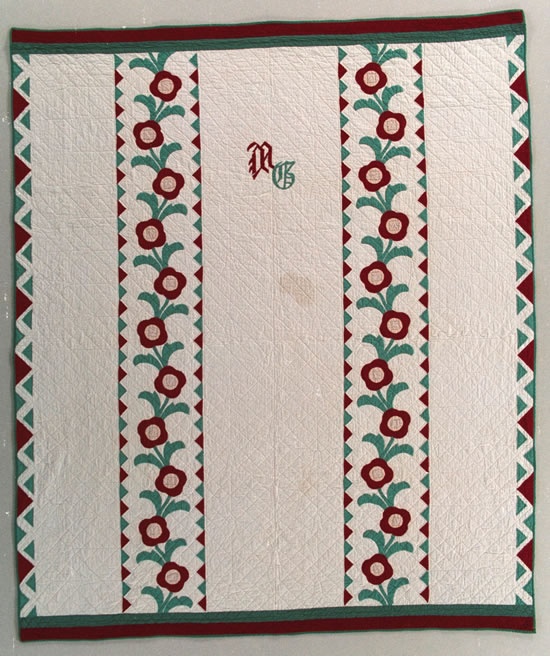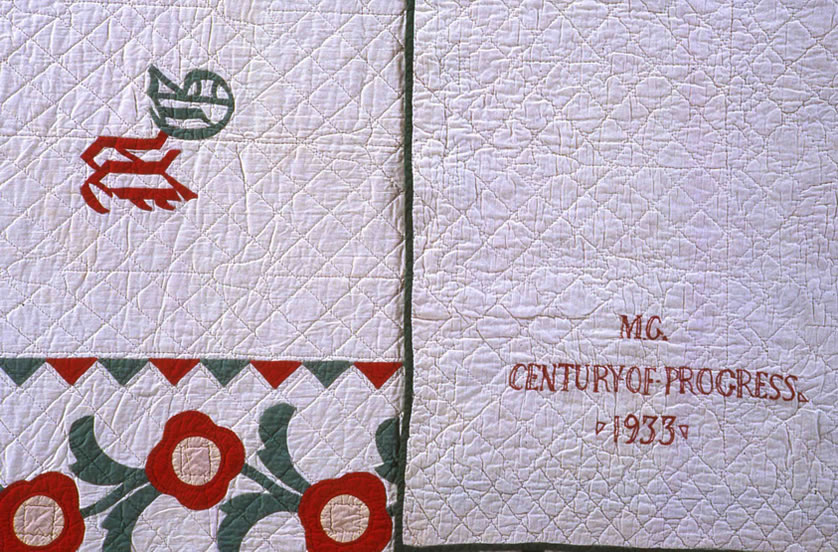
QUILT INDEX RECORD
18-14-19
Description:
This quilt, dated 1933 and bearing Gasperik's appliquéd initials, as well as the embroidered words "Century of Progress" on the back, may be the first quilt Mary completed. Its thick batting and lines quilted right across applique leaves perhaps betray a novice quilter's inexperience. It is clear that this quilt employed a commercial pattern or kit. Two very similar quilts are offered for sale by Cindy Rennels Antiques in January 2013. Rennels' website states both of these came from Indiana, but that the seller does not know the source of the pattern.
On all three quilts (The Gasperik version and the two Indiana versions) the green and red triangles comprising the vertical borders are appliqued, not pieced. The two Indiana versions do not have the solid red and solid green border strips Gasperik added to the top and bottom of her quilt. The Rennels' quilt I purchased is a summer spread. Gasperik's version has thick batting and is more than twice as densely quilted. If it can be assumed that the summer spread made by the unknown person displays the quiltING design proposed by the pattern (or kit) commercial source, then it can be said that Gasperik HAD to make changes, because the quilted lines on the summer spread do not connect and look incomplete along the two vertical borders. It appears that although Gasperik used a commercial pattern, she could not rely on it for complete quiltING instructions. It is interesting that even in what is likely to be Gasperik's first completed (cotton) applique quilt, she practiced two things which became a hallmark of almost all Gasperik quilts: she altered or added to a pattern or kit she was given or purchased, AND she placed special emphasis on creating and executing a complete and detailed quiltING design.
Essay:
With the help of a local group, the Tuley Park quilt club, Mary very quickly learned expert technique. But it is not clear to Salser if her grandmother made this quilt before or after she joined the Tuley Park group. The Chicago Park District had a booth at the Century of Progress Fair, in its own quilt display area. The Chicago Tribune on May 20, 1934 published in a column called "Notes of a Century of Progress", on page 12, the following notice: "The Chicago Park District will hold a quilt contest, which will be conducted in connection with its exhibit at A Century of Progress. Members or former members of any park quilting club may enter this contest tomorrow or Tuesday, May 21 and 22. The quilts will be on display at the exhibit in the Hall of States. Prizes will be given at the end of the Fair." At the time she began to make quilts, Gasperik may have believed that "Century of Progress 1933" should be appliqued to all quilts, and not just those made IN 1933 for that occasion. Late in life, Mary asked her daughter Elsie to NOT keep this quilt, probably because she did not wish it to be associated with her work. Instead, Elsie brought it to her daughter Susan. Although red, green and white are the national colors of several European countries, it is interesting that Mary selected colors of the Hungarian flag to make this, perhaps her first, quilt.
Where are the records for this quilt housed?
Mary Gasperik Legacy Project
Who documented this quilt?
Mary Gasperik Private Collection
Gasperik Legacy Project Number:
041
This is a:
Finished quilt
Quilt's title:
Double Trellis
Owner's name for quilt:
Double Trellis M. G.
How wide is the quilt?
72 inches
How long is the quilt?
91 inches
Shape of edge:
Straight
Shape of corners:
Straight
What color is the quilt?
Green; Red; White; Yellow
Quilt's condition:
Excellent/like new
Damage:
Stains; Other
Describe the damage:
single brownish stain of unknown origin in central area of quilt
Type of inscription:
Initials; Other
What is inscribed on the quilt?
Century of Progress 1933
What is the date inscribed on the quilt?
1933
Location of inscription:
multiple locations
Describe where the inscription was found:
M.G. on the front. Century of Progress on the back.
Time period:
1930-1949
When was the quilt finished?
1933
Family/owner's date for quilt:
1933
Date estimated by an antique dealer, quilt historian or appraiser:
1933
Who estimated the quilt's date?
Merikay Waldvogel
Further information concerning dates:
Estimated date is based on embroidered date, but it might also refer to the 1933 Century of Progress quilts that she saw at the 1933 Chicago World's Fair. Other quilts she made have the same dates. Nevertheless, this is one of her first quilts.
Describe the quilt's layout:
Vertical bands
Spacing of quilt blocks:
Strippy or vertical bands (in vertical rows separated by plain vertical bars)
Describe the borders:
Plain borders at top and bottom. Applique borders at right and left sides.
Fiber types used to make the quilt top:
Cotton
Fabric styles used in the quilt top:
Solid/plain
Applique techniques used to make the quilt top:
Hand Applique
Describe any unusual techniques used to make the quilt top:
Oddly, piecing was not used as a construction technique to make this quilt. Even though the red and green triangles, arranged on strips LOOK like piecing, they are in fact appliqued.
Materials used to make the back:
Cotton
What color is the back of the quilt?
White
Number of pieces of fabric in the quilt back:
3
Width of pieces on the back:
7", 32.5", 32.5"
Describe the back:
Solid/plain
Materials used in the quilt binding:
Cotton
Fabric structure of the binding:
Plain weave
How is the binding made?
Bias grain
What is the width of the binding (measure on the top only)?
less than a half inch
What kind of filling is used in the quilt?
Cotton
How are the layers held together?
Hand quilting
Color of thread used in the quilting:
white
Number of quilting stitches per inch, place 1:
6
Number of quilting stitches per inch, place 2:
7
Width between quilting lines:
1
Can you see any knots on the front or back of the quilt?
yes
Quilting designs used, overall motifs:
Echo; Grid diamond
Quilting designs used, background fills:
Grid/crosshatch
Features or notes about the quilt's appearance, materials, or construction:
In terms of construction, this quilt is Gasperik's crudest quilt. In fact, when Salser's mother brought her the quilt, as a gift, she told Susan that her mother had asked that she throw out the quilt and NOT keep it. Elsie couldn't bring herself to throw it out. Neither could Susan.
Quilt top made by:
Gasperik, Mary
Quilted by:
Gasperik, Mary
Where the quilt was made, city:
Chicago
Where the quilt was made, county:
Cook County
Where the quilt was made, state:
Illinois (IL)
Where the quilt was made, country:
United States
How was this quilt acquired?
Gift
Describe anything about the history of the quilt that wasn't already recorded in a previous field:
When Elsie Krueger gave this quilt to Susan she explained that her mother had in fact not wanted it kept. At that point, during Gasperik's final illness, Elsie was distributing some of her mother's best quilts, so it is not surprising that Gasperik did not wish this one to be considered a gift. It was a surprise to Susan to even see it, because she doesn't recall it being included in the occasional "quilt turning" events at her grandmother's house.
Why was the quilt made?
Unknown
The quilt was made to be used for:
Bedding, special occasion
Quilt is presently used as:
Keepsake/memento
Describe present uses of the quilt:
Mary's grandchildren regard her quilts as a unique collection to be preserved and appreciated.
Where did the maker get their materials?
Purchased new
Where did the maker find their pattern?
Unknown
Describe anything about the design of the quilt that wasn't already recorded in a previous field:
The source or sources are a mystery to Salser. Although the monogram "M" and "G" at first appeared to resemble one of the letter styles included in "The Wonder Package" (a box of patterns which is a source Gasperik used on some other quilts) in fact the patterns don't quite match.
Exhibitions where this quilt was displayed:
The Quilts of Mary Gasperik, Ravenswood Historic Site, Livermore, CA, March 14-15, 1992.
Publications (including web sites) where this quilt or maker was featured:
Merikay Waldvogel and Barbara Brackman. Patchwork Souvenirs of the 1933 Chicago World's Fair, (Nashville, TN: Rutledge Hill Press, 1993)102-103.
Merikay Waldvogel "One American Dream Comes True", Quilters Newsletter Magazine, March 2008, 46-49.
Ownership of this quilt is:
Private
Quilt owner's name:
Susan Krueger Salser
Quilt owner's country:
United States
Person filling out this form is:
Quilt owner; Relative of quiltmaker; Author/researcher
If you are a relative of the quiltmaker, how are you related? The quiltmaker is my:
Grandmother
Describe the relationship to the quilt's maker:
Grand-daughter Susan Salser began this research effort in 1991, after she and her two sisters divided up the quilts which belonged to their mother (Elsie Gasperik Krueger) who died in 1988. Her ongoing research has been fruitful and interesting.
Quiltmaker's maiden name:
Mihalovits, Maria
Quiltmaker's gender:
Female
Quiltmaker's birth date:
01/25/1888
Quiltmaker's birthplace, country:
Hungary
Quiltmaker's marriage date(s):
11/18/1906
Quiltmaker's date of death:
05/25/1969
Quiltmaker's ethnic background/tribal affiliation:
Hungarian
Quiltmaker's educational background:
Elementary School
In which kind of environment did the quiltmaker live?
Rural
Quiltmaker's city:
Chicago
Quiltmaker's county:
Cook
Quiltmaker's state:
Illinois (IL)
Quiltmaker's country:
United States
Quiltmaker's father's name:
Mihalovits, Istvan
Quiltmaker's father's birthplace:
Hungary
Quiltmaker's father's ethnic/tribal background:
Hungarian
Quiltmaker's mother's name:
Mihalovits, Vidoszava
Quiltmaker's mother's birthplace:
Hungary
Quiltmaker's mother's ethnic/tribal background:
Hungarian
Quiltmaker's spouse's/spouses' and /or partner's/partners' name(s):
Gasperik, Stephen
Quiltmaker's spouse's/spouses' and/or partner's/partners' ethnic/tribal background:
Hungarian
Quiltmaker's spouse's/spouses' and/or partner's/partners' occupation:
Milk Dealer/Grocery Store Owner/Butcher
Number of children:
3
How many of the quiltmaker's children were girls?
1 (Elsie 1909-1988)
How many of the quiltmaker's children were boys?
2 (Elmer and Stephen)
How did the quiltmaker learn to quilt?
From guild or club member; Self-Taught
When did the quiltmaker learn to quilt?
Age 40-49
Why does the quiltmaker quilt?
Pleasure; Other
Other notes on how the quiltmaker learned, and how and why they quilt:
At the time she made this particular quilt Gasperik was, apparently, teaching herself how to make quilts. The fact that later in life she asked her daughter to NOT keep this quilt suggests that she knew this was a beginner's effort and she did not want it to be regarded as representative of her work. Subsequently, Mary Gasperik made quilts because it was her life passion and greatest talent. As opportunities arose, she entered contests and exhibited them publicly. She also made special quilts for her family.
Does/did the quiltmaker belong to a group? Name of the group?
Tuley Park Quilt Club
Does/did the quiltmaker belong to a group?
Chicago, IL
What are the main activities of the group?
Group showings of quilts and quilting demonstrations.
Estimated number of quilts made by this quiltmaker:
more than 50
Does/did the quiltmaker sell quilts?
no
Does/did the quiltmaker teach quilting?
no
Artist statement or biography of quiltmaker or quilt group:
See introductory essay.
Who photographed this quilt?
Don Gonzalez
Access and copyright information:
Restricted
Copyright holder:
Hank Finn
Details
Cite this Quilt
Gasperik, Mar. Double Trellis. 1933. From Mary Gasperik Legacy Project, Mary Gasperik Private Collection. Published in The Quilt Index, https://quiltindex.org/view/?type=fullrec&kid=18-14-19. Accessed: 04/26/24
-
Essay
Mary Gasperik and the Tuley Park Quilt...
Waldvogel, Merikay
-
Exhibit
The Quilts of Mary Gasperik
Salser, Susan
-
Ephemera
The Quilts of Mary Gasperik
Salser, Susan
-
Gasperik, Mary Quiltmaker
Mary Gasperik Legacy Project
